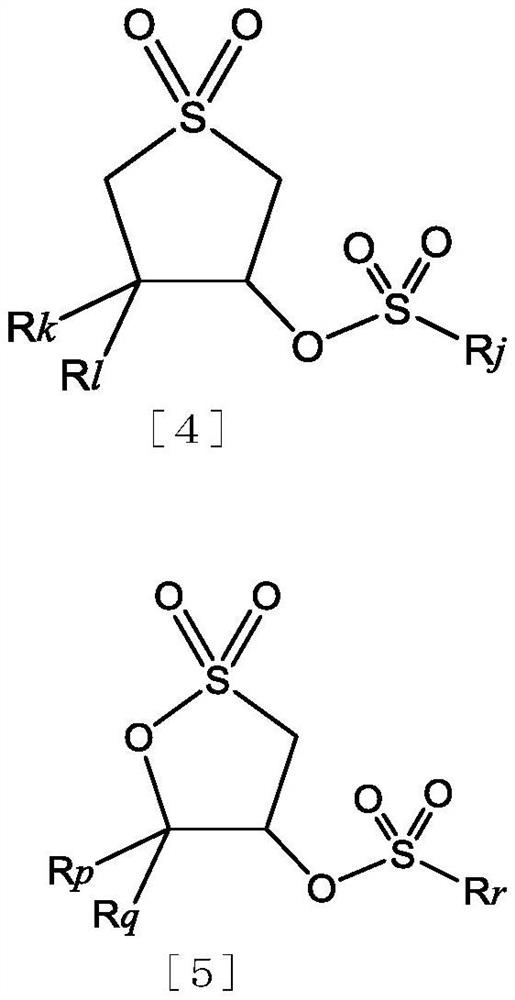Nonaqueous electrolyte solution and nonaqueous electrolyte secondary battery
A non-aqueous electrolyte, carbon number technology, applied in non-aqueous electrolyte storage batteries, secondary batteries, non-aqueous electrolytes and other directions, can solve the problems such as cyclic sulfonate compounds are not disclosed or given teachings and the like
- Summary
- Abstract
- Description
- Claims
- Application Information
AI Technical Summary
Problems solved by technology
Method used
Image
Examples
Embodiment 1-1~1-25 and comparative example 1-1~1-13
[0267] Using the electrolyte described in Table 1, with LiNi 0.8 co 0.1 mn 0.1 o 2 As the positive electrode material, graphite (containing silicon) is used as the negative electrode material to manufacture batteries, and the discharge capacity retention rate and internal resistance characteristics after storage are evaluated. The evaluation results are shown in Table 4. In addition, the test battery was produced as follows.
[0268] In LiNi 0.8 co 0.1 mn 0.1 o 2 5% by mass of polyvinylidene fluoride (hereinafter referred to as "PVDF") as a binder and 5% by mass of acetylene black as a conductive material were mixed with 90% by mass of the powder, and N-methylpyrrolidone was added to form a paste. This paste was applied on an aluminum foil and dried to prepare a test positive electrode body.
[0269] In addition, 5% by mass of silicon powder and 10% by mass of PVDF were mixed with 85% by mass of graphite powder as a binder, and N-methylpyrrolidone was further added to...
Embodiment 2-1~2-20
[0282] Except for using the electrolytic solutions described in Table 2, batteries were produced in the same manner as in Example 1-1, and the capacity retention rate during storage and the internal resistance characteristics after storage were evaluated. The evaluation results are shown in Table 5.
[0283] [table 5]
[0284]
[0285] The evaluation results of each example are relative values with the evaluation results of Comparative Example 1-1 being 100. The larger the value of "capacity retention rate during storage", the more desirable, and the smaller the value of "internal resistance characteristics after storage", the better. ideal.
[0286] According to the evaluation results in Table 5, it can be confirmed that compared with the case where LiFSI and (II) components are used in combination, when the (I) component and (II) component of the present invention are used in combination, the high-temperature storage characteristics can be improved in a well-balanced m...
Embodiment 3-1~3-14 and comparative example 3-1
[0288] Except for using the electrolytic solutions described in Table 3, batteries were produced in the same manner as in Example 1-1, and the capacity retention rate during storage and the internal resistance characteristics after storage were evaluated. The evaluation results are shown in Table 6.
[0289] [Table 6]
[0290]
[0291] The evaluation results of each example are relative values with the evaluation results of Comparative Example 3-1 being 100. The larger the value of "capacity retention rate during storage", the more desirable, and the smaller the value of "internal resistance characteristics after storage", the better. ideal.
[0292] From the evaluation results in Table 6, it can be confirmed that compared with Comparative Example 3-1 in which no component (I) was added, when the components (I) and (II) of the present invention are used in combination, the high-temperature storage characteristics can be improved in a well-balanced manner ( Capacity rete...
PUM
 Login to View More
Login to View More Abstract
Description
Claims
Application Information
 Login to View More
Login to View More - R&D
- Intellectual Property
- Life Sciences
- Materials
- Tech Scout
- Unparalleled Data Quality
- Higher Quality Content
- 60% Fewer Hallucinations
Browse by: Latest US Patents, China's latest patents, Technical Efficacy Thesaurus, Application Domain, Technology Topic, Popular Technical Reports.
© 2025 PatSnap. All rights reserved.Legal|Privacy policy|Modern Slavery Act Transparency Statement|Sitemap|About US| Contact US: help@patsnap.com



